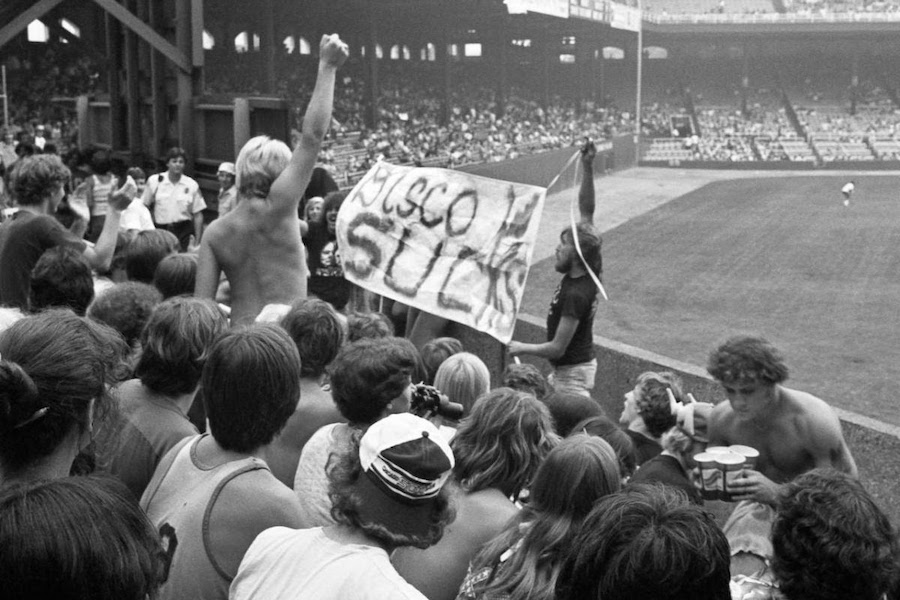
“This ain’t no party, This ain’t no Disco,
This ain’t no fooling around!
No time for dancing or lovey-dovey.
I ain’t got time for that now!”
—Talking Heads, Life During Wartime
As long as there has been culture, there have been cultural wars. Whenever there have been differences between individuals or groups within society, there has been a battle of ideas, styles, language, narrative, dress, and entertainment.
While they may sometimes be dressed up as new phenomena, culture wars are firmly rooted in earlier American class, racial, and gender struggles.
Producers Lisa Q. Wolfinger and Rushmore DeNooyer do a great service in their highly entertaining and somewhat painful new documentary The War on Disco by reporting on this battlefield. These war correspondents have created a social and cultural history of the Seventies. In doing so, they help us understand the status of that never-ending war, the winners, losers, and casualties. Whether this understanding can help us avert such fighting is an entirely different question!
The film opens with the iconic tracking shot of Mr. Disco, John Travolta, dancing across the screen to the Bee Gees soundtrack of the Seventies Saturday Night Fever, the film which propelled them all to fame. The music is infectious. Travolta is grace and glamor incarnate. Were these times better, worse, different?
While it may not have been the Balkans or the Middle East, clearly the Seventies was a volatile powder keg in the U.S. It was a decade of fear, anxiety, and confusion, with a malaise of unemployment, rising gas prices, Vietnam War fallout, and various groups contesting the status quo.
Blacks, women, and gays pushed for greater rights and recognition. Their struggle for jobs and justice threatened the existing white patriarchy. But the voice of the underrepresented groups found easier cultural expression than actual economic and social achievement.
The catchy beats and melodies, heartfelt lyrics, and flamboyant movement of disco music captured enormous popularity. At first, disco dance was the expression of an underclass. It sprang up from clubs where minorities were safe to express their rebellion against the prevailing culture. With growing popularity, these clubs could set their own standards flaunting the white majority. Soon the music of disco stars Gloria Gaynor and the Village People dominated the airwaves. Steve Rubell opened New York’s Studio 54, a club which notoriously set its own cultural standards. Almost half the radio stations in the U.S. came to play disco.

The War on Disco explores how the white working class fought back against the upstart minority music. At the core of the anti-disco anxiety was fear of change represented by what white males saw as the feminization of music, obsession with appearance, and the rise of the underclass.
The culmination of this backlash took the form of the Chicago White Sox 1979 anti-disco promotion. Team fans who brought a disco record to the ballpark would get discounted tickets on the night of Fri., July 12. Between games of the team’s doubleheader, the collected records would be exploded on the field.
The team had been playing poorly. Attendance was down. But the promotion proved successful beyond the wildest imaginations of White Sox marketer Mike Veeck and the promotion’s originator DJ Steve Dahl. The park was completely filled with rowdy anti-disco fans who applauded the symbolic violence against what they saw as race music.
The documentary does an excellent job of setting the stage for this stunning eruption of culture war. But Wolfinger and DeNooyer do not completely seize the moment by offering a more thorough denouement. Did the downfall of disco lead to the reassertion of mainstream rock ’n’ roll? Was consciousness raised along with the decibel level from blowing up the records? Who won the battle, the war?
In a situation fraught with irony, the doc missed the opportunity to question and compare. A generation earlier the very rock ’n’ roll which the white working class were championing against disco had been feared as Black music that had risen from Black rhythm and blues. How did these “dangerous” cultural changes compare with the just concluded alien British Invasion, the new techno-pop, country and western, nascent hip-hop, or its roots in regional music?
Maybe someday, when the smoke settles, we can count the casualties, withdraw gracefully from the conflict as we have done in Afghanistan, Vietnam, etc., and declare the U.S. the winner—no matter what the outcome. There’s plenty more music to be made.
The War on Disco premieres Mon., Oct. 30, on PBS as part of its award-winning American Experience series and streaming on PBS.org. The teaser can be viewed here.
We hope you appreciated this article. At People’s World, we believe news and information should be free and accessible to all, but we need your help. Our journalism is free of corporate influence and paywalls because we are totally reader-supported. Only you, our readers and supporters, make this possible. If you enjoy reading People’s World and the stories we bring you, please support our work by donating or becoming a monthly sustainer today. Thank you!










